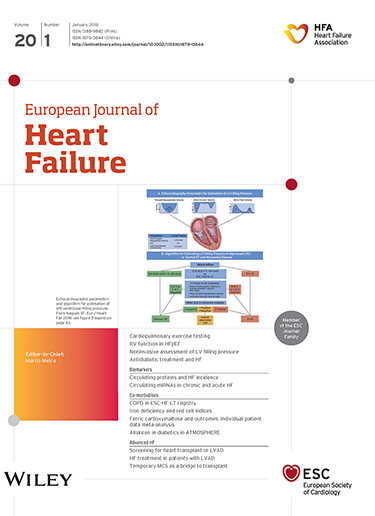收缩期和舒张期功能的综合轨迹与心力衰竭风险的差异与射血分数和蛋白质组学特征的保留和降低有关
IF 10.8
1区 医学
Q1 CARDIAC & CARDIOVASCULAR SYSTEMS
引用次数: 0
摘要
目的联合模拟晚年左室射血分数(LVEF)和E/A比的纵向测量,并评估预测的轨迹隶属度是否与心力衰竭风险相关。方法和结果采用贝叶斯非参数轨迹方法,对2000-2004年(65±5岁)、2011-2013年(75±5岁)和2018-2019年(81±5岁)接受≥2次超声心动图检查的747名杰克逊心脏研究参与者的轨迹进行建模。使用所得模型,我们基于LVEF和E/A比值的单时间点测量,预测了4419名不同动脉粥样硬化风险社区(ARIC)研究参与者的轨迹成员(年龄75±5岁;“测试队列”)。多变量Cox模型评估了预测轨迹与保留心力衰竭(HFpEF)和射血分数降低(HFrEF)之间的关系。我们评估了4877血浆蛋白(SOMAscan)与预测轨迹的关系,并进行孟德尔随机化来评估对LVEF和容积的因果影响。确定了六个轨迹:粉红色(患病率50%)和浅绿色(17%)- LVEF增加,E/A比随年龄下降;红色(22%)- LVEF未增加;深绿色(4%)- LVEF下降;橙色(2%)- LVEF急剧下降,E/A比率上升;蓝色(4%)-尽管LVEF增加,但E/A比率仍在上升。在测试队列中,红色和深绿色与HFrEF单独相关,蓝色与HFpEF单独相关,橙色与粉红色相比,两者都相关。轨迹隶属度在预测心力衰竭和HFpEF方面提供了增量价值。孟德尔随机化确定了13种轨迹相关蛋白对LVEF和体积的潜在因果影响。结论:贝叶斯非参数模型确定了与HFpEF和HFrEF不同的心功能轨迹,有望改善风险预测并实现治疗靶点的发现。本文章由计算机程序翻译,如有差异,请以英文原文为准。
Integrated trajectories of systolic and diastolic function differentially associate with risk for heart failure with preserved and reduced ejection fraction and proteomic profiles
AimsTo jointly model longitudinal measures of left ventricular ejection fraction (LVEF) and E/A ratio in late‐life, and to assess whether predicted trajectory membership is associated with heart failure risk.Methods and resultsUsing a Bayesian non‐parametric trajectory approach, trajectories were modelled among 747 Jackson Heart Study participants who underwent ≥2 echocardiograms in 2000–2004 (age 65 ± 5 years), 2011–2013 (75 ± 5), and 2018–2019 (81 ± 5). Using the resulting model, we predicted trajectory membership for 4419 distinct Atherosclerosis Risk in Communities (ARIC) study participants based on single time‐point measures of LVEF and E/A ratio (age 75 ± 5 years; ‘testing cohort’). Multivariable Cox models assessed the relationship between predicted trajectory and incident heart failure with preserved (HFpEF) and reduced ejection fraction (HFrEF). We evaluated associations of 4877 plasma proteins (SOMAscan) with predicted trajectory and performed Mendelian randomization to assess causal effects on LVEF and volume. Six trajectories were identified: pink (prevalence 50%) and light green (17%) – increasing LVEF, decreasing E/A ratio with age; red (22%) – no increase in LVEF; dark green (4%) – declining LVEF; orange (2%) – steeply declining LVEF, rising E/A ratio; and blue (4%) – rising E/A ratio despite increasing LVEF. In the testing cohort, red and dark green associated with HFrEF alone, blue with HFpEF alone, and orange with both compared to pink. Trajectory membership provided incremental value in predicting heart failure and HFpEF. Mendelian randomization identified potential causal effects of 13 trajectory‐associated proteins on LVEF and volume.ConclusionsBayesian non‐parametric modelling identifies cardiac function trajectories differentially associated with HFpEF and HFrEF and holds promise to improve risk prediction and enable therapeutic target discovery.
求助全文
通过发布文献求助,成功后即可免费获取论文全文。
去求助
来源期刊

European Journal of Heart Failure
医学-心血管系统
CiteScore
27.30
自引率
11.50%
发文量
365
审稿时长
1 months
期刊介绍:
European Journal of Heart Failure is an international journal dedicated to advancing knowledge in the field of heart failure management. The journal publishes reviews and editorials aimed at improving understanding, prevention, investigation, and treatment of heart failure. It covers various disciplines such as molecular and cellular biology, pathology, physiology, electrophysiology, pharmacology, clinical sciences, social sciences, and population sciences. The journal welcomes submissions of manuscripts on basic, clinical, and population sciences, as well as original contributions on nursing, care of the elderly, primary care, health economics, and other related specialist fields. It is published monthly and has a readership that includes cardiologists, emergency room physicians, intensivists, internists, general physicians, cardiac nurses, diabetologists, epidemiologists, basic scientists focusing on cardiovascular research, and those working in rehabilitation. The journal is abstracted and indexed in various databases such as Academic Search, Embase, MEDLINE/PubMed, and Science Citation Index.
 求助内容:
求助内容: 应助结果提醒方式:
应助结果提醒方式:


